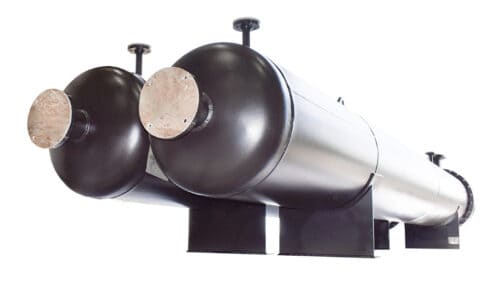Designing a Shell and Tube Heat Exchanger for Viscous Applications
When designing a shell and tube heat exchanger for viscous products, such as a whey application in the dairy industry or an asphalt application in the roofing industry, there are several options that can be considered to ensure efficient and effective heat transfer. Some of these options include:

Shell & Tube Heat Exchangers for an Asphalt Application
Increase the Tube Diameter: By increasing the tube diameter, the fluid velocity will decrease, which reduces the pressure drop. This is particularly effective for viscous fluids, which require a lower fluid velocity to transfer heat effectively.
Use Baffles: Baffles are plates that are placed inside the shell of the heat exchanger to direct the flow of fluid. By using baffles, the fluid is forced to flow in a serpentine pattern, increasing the amount of time it spends in the heat exchanger and improving heat transfer.
Increase the Number of Tubes: Increasing the number of tubes in the heat exchanger increases the surface area available for heat transfer, which can improve efficiency.
Use Counter-Flow Design: A counter-current flow design can be used for a close temperature approach as it results in a larger temperature difference across the heat exchanger. In this design, the hot and cold fluids flow in opposite directions, which results in the highest temperature difference at the point of exit.
Use High Turbulence Flow: Viscous fluids require a high heat transfer. Therefore, by increasing the turbulence in the flow, the heat transfer efficiency can be improved. This can be achieved by using a fluid with a higher velocity.
Use High Velocity Flow: Going back to the whey protein example, whey protein tends to foam and create a layer of protein on the surface of the heat exchanger. By using high velocity flow, the protein can be prevented from sticking to the surface, which can improve the heat transfer efficiency.
Enerquip Shell and Tube Heat Exchangers for Viscous Applications
Overall, the design options for a shell and tube heat exchanger for viscous products will depend on the specific characteristics of the fluid being used and the desired level of heat transfer efficiency. It is important to consult with a qualified engineer to ensure that the heat exchanger is designed to meet the specific requirements of the application.
Ready to talk? Contact us or request a quote today.
More from the Enerquip Blog
- Custom and Stock Shell & Tube Heat Exchangers
- Heat Exchanger vs. Asphalt Heater for Asphalt Applications
- How Steam Bustles Improve Efficiency in Shell and Tube Heat Exchangers
- Machined vs. Fabricated Channels
- Understanding Finish Requirements for Shell and Tube Heat Exchangers
- Industrial Heat Exchanger FAQs
- Standards for Sanitary & High-Purity Processing Equipment

